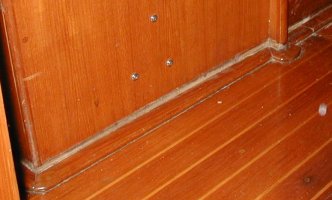ted_reshetiloff
Contributing Partner
I have noticed on my 89' E-38 -200 that the cabinet which the galley sink and icebox sit in seems to have lifted away from the cabin sole along teh section that runs lengthwise and connects to the dinette seat. I will take a picture tomorrow and post but I am wondering if I have somehow flexed the hull. It is very strange as all the doors seem to close fine and the rig tension is not screaming tight. I dont know if it was like this and I am just now noticing it or if it has come from sailing the boat hard upwind. There doesnt seem to be any paly that I can detect when sailing, nor can I move the cabinet by pushing on it but it looks like it has been lifted up 1/2 t0 3/4 of an inch. I know pictures pictures pictures. The door to the v berth is hard to close but has been that way even when the boat was on the hard with rig down. Nothing else seems to have shifted or moved and teh aft cabin and head doors close fine, but this has me a little concerned... More to come once I take the pictures.



